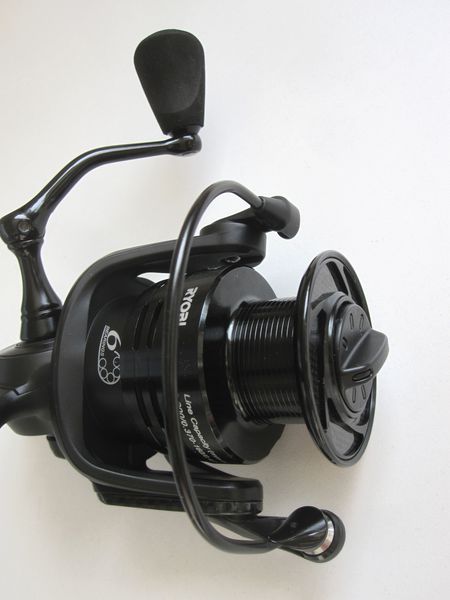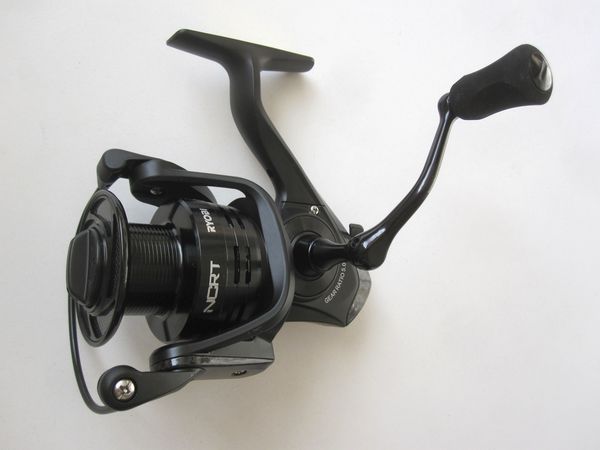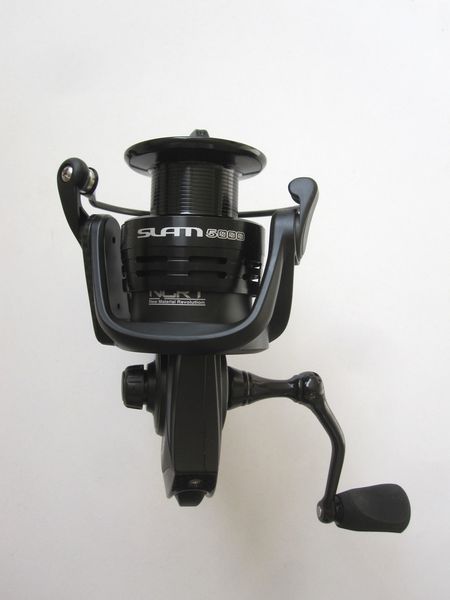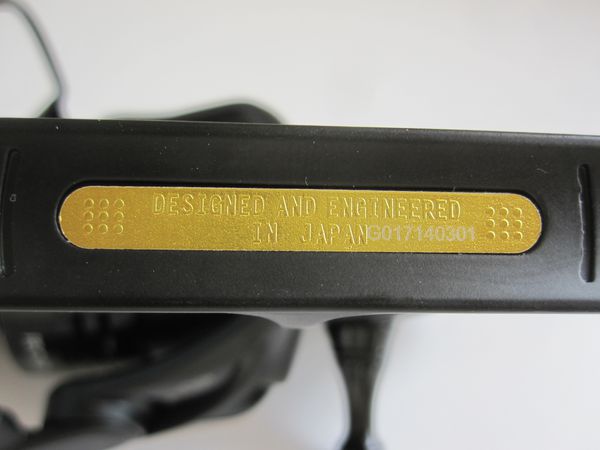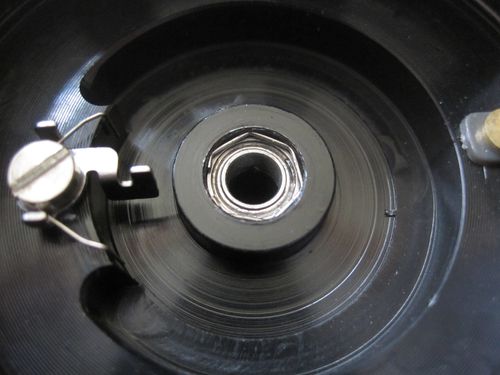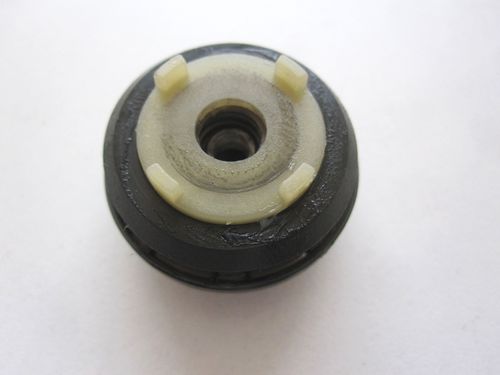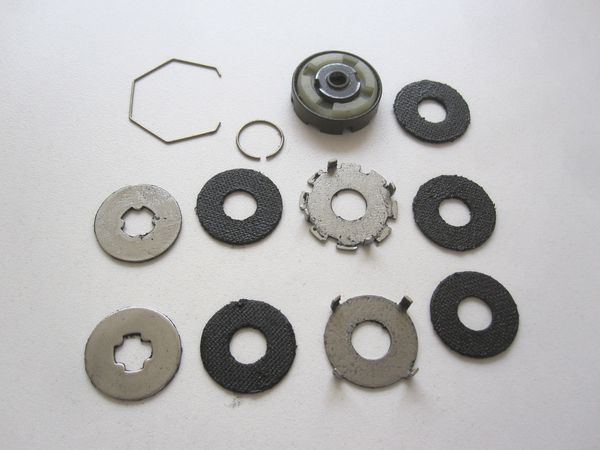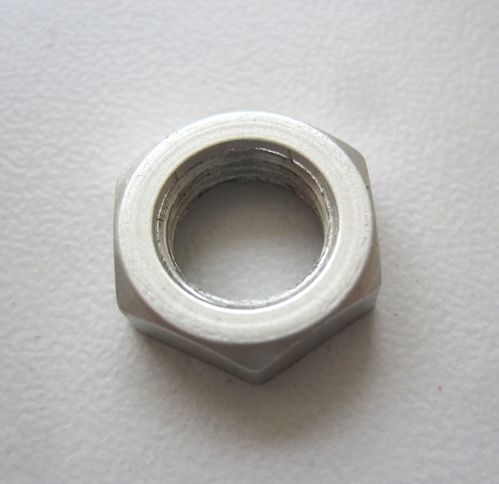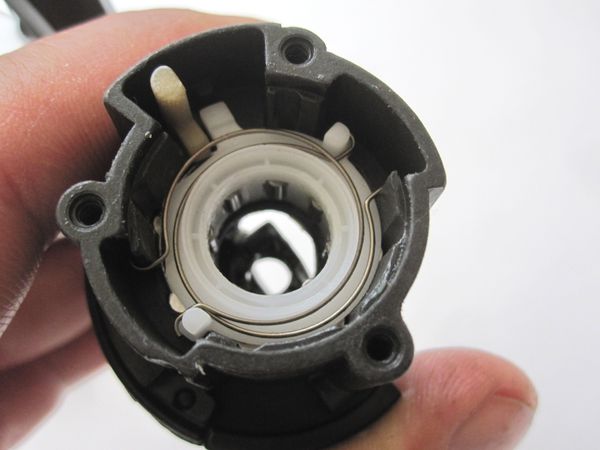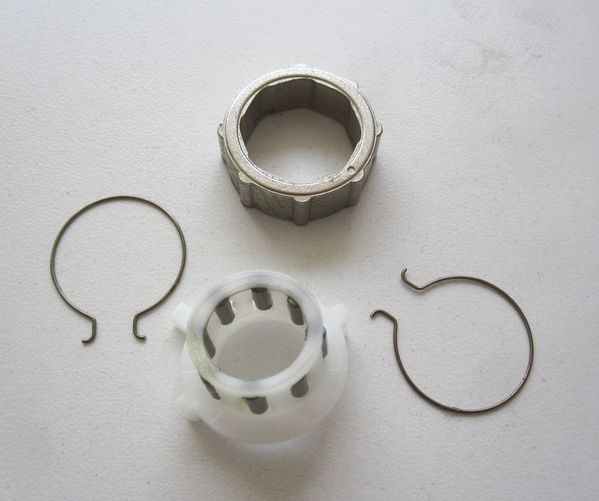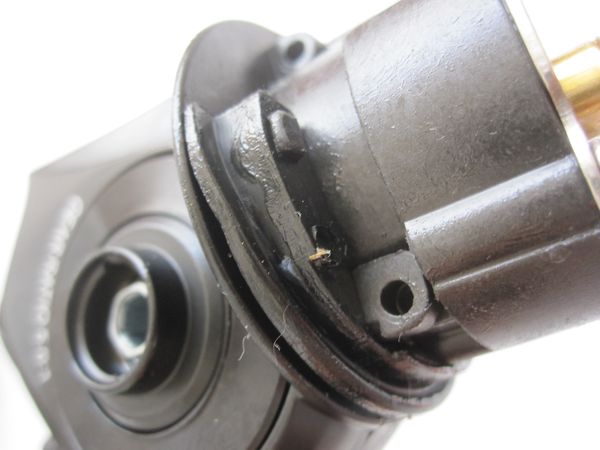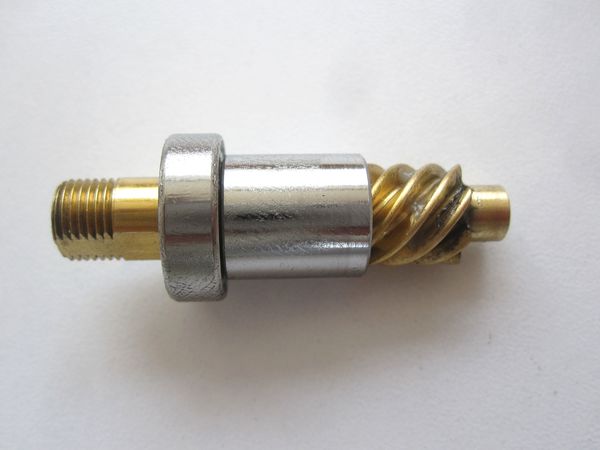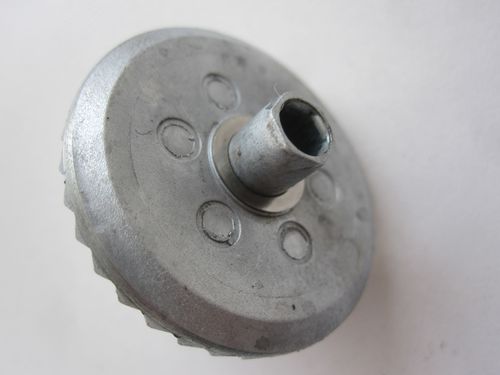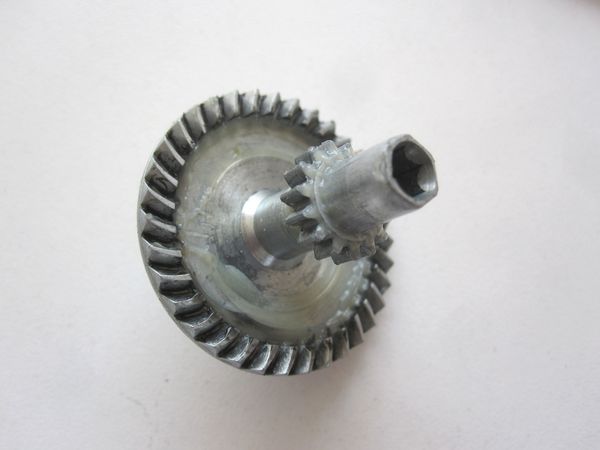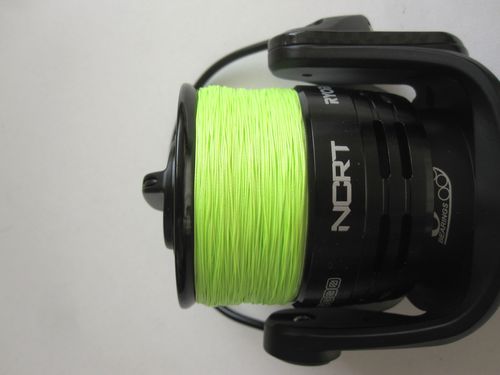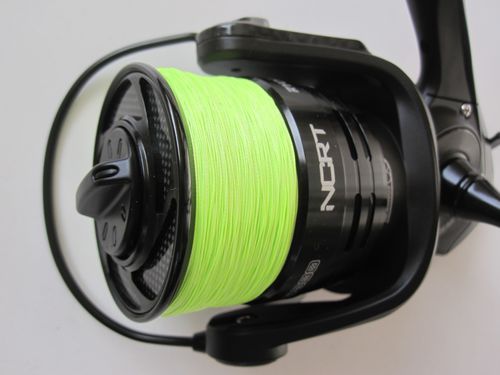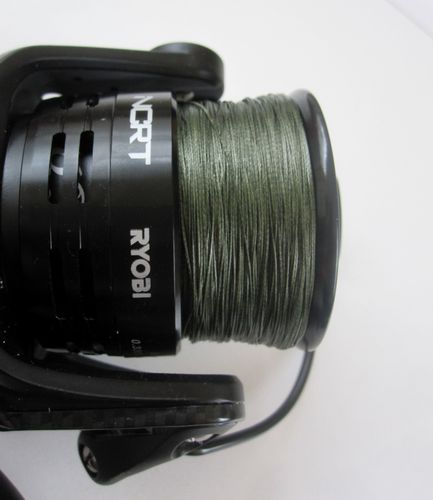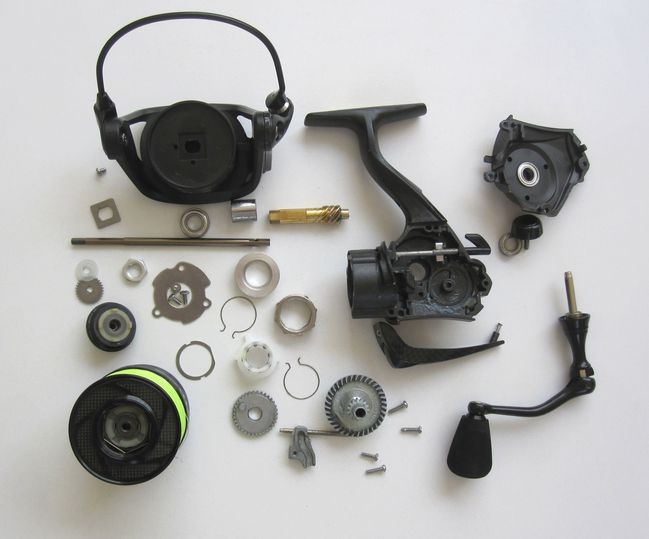Le seul moulinet Ryobi que je possédais avant le Slam est cette espèce de « chose » ci-dessous, à 0 roulement, que j’avais acheté dans un supermarché il y a plus de 25 ans et dont la manivelle à masselotte m’avait bêtement séduit. Inutile de vous dire qu’au bout de deux ou trois utilisations, je l’ai remisé sur une étagère en poussant un soupir, mais ce n’était pas grave car je ne l’avais payé que quelques dizaines de francs à l’époque.

J’étais donc vacciné contre cette marque Japonaise plus connue pour ses appareils de bricolage électroportatifs. Entretemps bien sûr Ryobi s’est rattrapé en sortant le « Safari » qui existe toujours et dont la solidité n’est plus à démontrer ainsi que quelques autres modèles vendus sous diverses appellations de différentes marques, son avatar le plus célèbre étant le Zauber qui s’est vendu sous des tas de noms différents. Puis vers les années 2000 Ryobi a revendu son secteur pêche à une société chinoise et on en a moins entendu parler, si ce n’est pour certains modèles comme le Carnelian et l’Artica, aux qualités douteuses selon ses utilisateurs.
En 2014 Ryobi nous sort le modèle Slam, aux caractéristiques plutôt alléchantes, jugez plutôt :
Caractéristiques :
- 6 roulements japonais inox
- Bâti, carter, rotor Carbone/Titanium NCRT 20% plus léger et 40% plus résistant que les composites graphite habituels
- Engrenages haute précision RFO
- Axe Titanium renforcé
- Anti-retour infini à aiguilles
- Guide-fil Titanium anti-vrillage
- Anse de panier creuse Titanium
- Bobine aluminium avec inserts "woven carbon"
- Frein waterproof multidisque micrométrique, progressif et puissant
- Manivelle CNC anodisée
- Bouton de manivelle EVA ergonomique, ultra-léger
Sur le papier c’est prometteur ! J’ai donc choisi le modèle 5006 (on le trouve également en taille 1006 et 3006) pour un poids de 315g avec un frein annoncé à 7,5kg. En fait c’est le modèle 5000 et il existe un modèle 6000, à peine plus gros.
L’aspect général et la finition « all black » avec inserts carbone sont assez réussi et il est en effet très léger avec un poids réel de 317g. La fluidité est correcte, meilleure que celle du Fin-Nor Sportfisher que nous avons vu précédemment, mais il n’est livré qu’avec une seule bobine.
Sur le pied est inscrit : « Designed and engineered in Japan » ce qui est sûrement faux puisque comme on le sait, les moulinets Ryobi sont désormais sous licence chinoise. Un numéro de série est apposé, au cas où on vous le vole sans doute …
…
La bobine, le frein et l’axe
La bobine est en aluminium ajouré avec des inserts carbone sur le dessus pour faire joli mais je doute que ça allège l’ensemble. Assez large, elle semble bien adaptée au lancer léger/mi-lourd. Elle possède à sa base un roulement maintenu par un petit clip, disposition plutôt originale car les roulements se positionnent sur l’axe d’habitude, mais le résultat est le même : ça aide à diminuer l’inertie du frein, c’est toujours une bonne chose.
Le bouton de frein est scellé par une sorte de capsule en plastique possédant 4 ergots qui viennent ensuite s’emboîter au sommet de la pile, sans doute pour éviter que les différents disques ne tournent. Le ressort est en partie invisible mais j’ai l’impression qu’il est assez large et efficace. Un petit joint en caoutchouc sur le dessous vient justifier la mention « waterproof » mais comme je l’ai déjà dit, ces joint ne sont pas étanches, tout au plus protègent-ils la pile des intrusions de sable et de sel en excès.
La pile de frein est à mon avis inutilement compliquée. Pas moins de 5 disques en carbone imbriqués dans un système de disques en acier dont les pattes se fixent dans des encoches prévues à cet effet pour maintenir la cohésion.
Au fond, le moyeu de la bobine est en croix pour que l’ensemble de la pile vienne s’y insérer sans tourner.
Je préfère de loin le système du Penn Conflict ou du Fin-Nor Spinfisher, plus simple et tout aussi efficace. Le problème de cette pile est qu’elle ne se démonte pas aisément, chaque pièce devant être bien à sa place sous peine de perdre en puissance de freinage.
Autre problème lorsque je testais la puissance du frein au peson, une brusque perte d’adhérence au bout de plusieurs tractions autour de 6kg : le frein retombait à 3kg alors que l’écrou n’avait pas bougé. En examinant la pile en détail, je me suis rendu compte que c’était dû à un excès de graisse sur les disques ; en chauffant, ils liquéfiaient la graisse qui coulait au fond de la pile et la faisait patiner. Une fois les différents disques bien essuyés le problème à disparu et j’ai atteint (et même un peu dépassé) les 7,5kg de puissance annoncée, bouton de frein serré presque à fond. Pour une fois pas de mensonge sur la puissance du frein ! Le bras du galet à bien supporté l’épreuve sans toucher la bobine. L’axe n’a pas bronché. Le seul reproche que je ferais à ce frein est son manque de régularité. A partir de 5kg, on sent des à-coups sur les longues tirées, c’est certainement dû à l’étroitesse de l’axe et de la rondelle de retenue de la bobine, qui doit avoir tendance à s’incliner d’un côté ou de l’autre et qui ne place pas la bobine parfaitement parallèle à l’axe, d’où cette sensation de frottement parfois. Alors 7,5kg oui, mais on est loin de la fluidité du Fin-Nor, ce frein est assez irrégulier, bien que puissant.
Bien sûr cette puissance de 7,5kg est le maximum que ce moulinet peut supporter et sûrement pas longtemps : l’antiretour risque de lâcher avant les disques comme nous le verrons plus loin. Disons que sa plage raisonnable d’utilisation se situe autour de 4/5kg, ce qui permet de mater n’importe quel poisson d’eau douce de moins de 20kg avec un peu de patience et de douceur. Pour la mer, divisez par deux ! C’est finalement tout à fait acceptable compte-tenu de la taille relativement modeste du moulinet.
L’axe lui-même est donc très fin avec ses 4mm de diamètre et lorsque je l’ai vu j’ai eu du mal à croire qu’il était en titane, à cause de sa couleur tirant légèrement vers le bronze. Pourtant, une fois pesé et comparé avec une tige en acier de même diamètre et de même longueur, force est de constater qu’il pèse deux fois moins et qu’il est amagnétique. Conclusion : ce n’est peut-être pas du titane pur mais ça y ressemble bougrement. La couleur s’explique soit par une trempe ou par une anodisation (le plus probable), soit par un alliage au cuivre, en tout cas cet axe est très léger, très solide et totalement inoxydable. Ce n’était donc pas du Pipotium, ni du Baratinium comme je l’avais craint un instant ! Dommage qu’il soit si fin car comme nous l’avons vu, cela influe sur la régularité du freinage. L’idéal serait une section de 5mm ou alors de lui adjoindre un manchon en laiton, quitte à l’alourdir.
L’écrou qui maintient le rotor est vraisemblablement lui aussi en titane.
Le rotor
Réalisé en Carbone/Titanium NCRT selon le fabriquant, il serait plus léger et plus résistant que les autres composites. Daiwa a le Zaïon, Shimano le CI4, pourquoi pas le NCRT… En tout cas les bras sont robustes pour leur taille et ne se sont que peu déformés, même à 8kg de traction.
A noter qu’à sa sortie, le pignon est maintenu par une pièce métallique carrée avant l’écrou de fixation : un + pour la solidité.
Je ne sais pas si l’arceau de pick-up est en titane creux, mais c’est plausible.
Le ressort à compression est très costaud et effectivement il claque fort quand on le referme (d’où le nom du moulinet « Slam » : claquer en anglais ?).
Une vis externe côté galet et une interne de l’autre.
Le galet est monté sur un roulement et il est lui aussi en titane (ou en alliage de titane). Il tourne parfaitement.
Un très bon et très solide ensemble rotor/pick-up qui ne devrait pas flancher au bout de quelques utilisations, comme c’est souvent le cas.
L’antiretour
Nous avons là un antiretour typiquement Chinois : Equipé de 8 rouleaux, il n’est pas muni des traditionnels ressorts en V mais d’un système de collier actionné par deux ressorts circulaires. Lorsque l’antiretour est engagé, le collier en plastique comprime les rouleaux contre le collier en acier tous en même temps et non pas individuellement comme avec les ressorts en v. C’est efficace, mais le problème avec ce type d’antiretour c’est que souvent un léger recul se fait sentir et c’est le cas ici. J’émets aussi quelques réserves sur sa capacité à supporter longtemps 7,5kg de traction continue… Disons que pour des poissons de taille moyenne, il ne devrait pas poser de problème.
Le train d’engrenage
En démontant le rotor, on s’aperçoit qu’il y a un joint d’étanchéité à la base du bâti. C’est bien mais pourquoi ne fait-il pas le tour complet ? On va dire que c’est un petit plus.
Le pignon en laiton est porté par un roulement après l’antiretour et par une gorge sans palier. Cette absence de palier se justifie par la nature composite du bâti, qui absorbera mieux les frottements que l’aluminium, mais un petit roulement aurait été préférable.
La roue de commande est bien proportionnée, assez large et vraisemblablement en fonte d’aluminium de bonne qualité. Pour le prix, il n’y a rien à redire. Elle est portée par deux roulements, c’est la moindre des choses…
Le système d’oscillation est le classique combiné roue à ergot + came en S, le tout en fonte d’aluminium aussi. Comme pour le pignon, la roue à ergot repose directement sur un petit bourrelet du bâti en composite. Ça frotte mais c’est tolérable.
La came d’oscillation est soutenue par un guide qui la traverse et qui est fixé en bas du châssis. C’est efficace et solide, elle ne risque pas de dérailler, mais un rail ou un guide supplémentaire en haut aurait été encore mieux.
Dans l’ensemble, les frictions sont assez faibles mais bien entendu il faudra voir avec le temps et mettre de la graisse régulièrement pour éviter cette sensation de « grattage » si courante avec ce type d’engrenage.
L’enroulement obtenu est correct, bien qu’il manque un peu de régularité. Un léger bourrelet se forme en haut et en bas de la bobine, comme pour le Penn Conflict. Ça ne gêne pas les lancers et n’occasionne pas de perruques, c’est juste inesthétique. Deux cales supplémentaires sont fournies pour varier la forme de l’enroulement mais franchement elles n’ont pas beaucoup d’incidence : en rajoutant une cale, l’enroulement reste pratiquement identique, un peu plus conique. Par contre, en enlevant la cale d’origine et en la remplaçant par une des cales d’appoint (moins épaisses), on obtient un enroulement conique inversé, bien meilleur à mon avis en termes de distance de lancer. C’est finalement la configuration que j’ai choisi, bien que cela accentue les bourrelets...
La manivelle
Elégante manivelle tournée comme une pièce d’échec à sa base, elle est malheureusement de type hexagonal, avec les problèmes de jeu qui vont avec. Ici pour le coup je m’attendais à ce qu’elle se visse directement dans la roue de commande ! Et effectivement il y a du jeu, même serrée à fond, dommage.
Pas de joints d’étanchéité des deux côtés du carter, il faudra donc penser à bien graisser ce traditionnel point faible pour prévenir les intrusions d’eau.
La poignée se démonte facilement mais n’est pas portée par un roulement, seulement un palier. Elle est en EVA de bonne qualité, confortable en cours d’utilisation.
Le test en condition réelle
Trois matinées passées en sa compagnie au bord du lac de Bimont m’ont apporté la preuve que ce moulinet était un excellent lanceur. Plus de 60m la plupart du temps, avec diverses tresses et des leurres entre 20 et 65gr (et une nouvelle canne dont je parlerai bientôt, ma Tenryu ayant rendu l’âme…). Aucunes perruques à signaler. Le pick-up très solide ne se rabat pas même sur des lancers très soutenus. Grâce à son poids très léger, il se fait complètement oublier en action de pêche et sa fluidité reste bonne.

Pas beaucoup de poissons actifs en ce moment hélas, seule une misérable perche de 20cm viendra taper sur mon crankbait en tout et pour tout ! Je n’ai donc pas pu juger le frein sur un poisson combatif. Il faut dire que juillet est un mois difficile car le garde-manger des carnassiers regorge de victuailles : les perches se gavent d’alevins et les brochets n’ont que l’embarras du choix, il leur suffit d’ouvrir la gueule pour engamer des bancs d’ablettes entiers ! L’abondance de nourriture ne joue pas en notre faveur, messieurs les carnassiers jouent les fines gueules… Peut-être aussi que le pauvre pêcheur que je suis n’a pas su trouver la bonne technique ! Toujours est-il que j’ai vraiment apprécié le Slam, sa légèreté et son pick-up solide, sa capacité à lancer loin et son ratio bien adapté à la pêche aux leurres. Il me rappelait presque par certains côtés les anciens Mitchell 300, je ne sais pas pourquoi, juste une sensation…
Conclusion
De mes trois bêtes noires (Penn Conflict, Fin-Nor Rainer Korn et Slam), c’est donc bien le Slam qui arrive en tête, sans discussion possible. Ses composants de qualités, son frein réaliste, ses engrenages honnêtes et enfin son prix raisonnable (moins de 120€) le place en haut du podium des moulinets légers moyen de gamme récemment sortis dans le commerce. Vous pourrez l’utiliser sans problème en mer pour les pêches au lancer, en traction et en verticale, si vous prenez la précaution de bien essuyer la graisse trop abondante qui recouvre les disques de frein. Presque totalement inox et intelligemment conçu, il devrait pouvoir dépasser les 3 ans d’espérance de vie, ce qui en ferait alors un vieillard compte tenu de l’obsolescence programmée de ces chères machines… Je lui mets donc un bienveillant 12,5/20 en espérant qu’une version plus musclée voit le jour, avec un engrenage Wormshaft, un frein simplifié, un meilleur antiretour et une bobine supplémentaire siouplait. Il faut bien comprendre que le Ryobi Slam n’est pas une bête de concours et ma conclusion définitive pour tous ces moulinets à moins de 150 € est qu’il leur manque toujours quelque chose. Aucun n’atteint vraiment un niveau de fiabilité suffisant ; il y a toujours un détail qui cloche, que ce soit au niveau du frein, de l’axe, des engrenages, de l’antiretour ou de la manivelle. Je dirais même que c’est fait exprès. Je ne suis pas ingénieur, mais si je voulais fabriquer un bon moulinet à coût raisonnable, je saurais comment m’y prendre : Un frein en carbone simple avec un axe suffisamment épais, une bobine large et légère, porté par un roulement, un antiretour solide, des engrenages en alliages d’aluminium plutôt qu’en zinc (ou alors en alliage de zinc de qualité, pas du Zamak basique!), un système d’oscillation précis et une manivelle qui se visse dans la roue de commande. Est-ce trop demander ? Il semblerait que oui. Seuls les modèles à plus de 200€ réunissent en général ces conditions (j’en parlerai prochainement) et je trouve cela dommage dans la mesure où ces trois moulinets, si l’on prend en compte leurs qualités respectives, pourraient n’en former qu’un seul qui serait tout à fait correct, la preuve que c’est possible. Mais les fabricants en vendraient moins… L’offre pléthorique que nous avons actuellement en matière de moulinet est une affaire de tactique commerciale bien rôdée ! L’idée est simple : la plupart des pêcheurs n’osent pas investir dans un moulinet correct à plus de 200€ (seuil psychologique), donc on leur en propose une multitude à 120/150€ qui ne feront qu’une saison, ce qui les obligera à en acheter un autre la saison suivante, arguments novateurs à l’appui, comme ça on leur fait dépenser d’avantage d’argent de manière indolore. Il y a bien sûr des exceptions comme le Shimano Spheros FB en taille 4000 ou 5000 ou le Abu Garcia Soron 40 qui sont des moulinets très performants dans cette gamme de prix, mais mon conseil si vous ne voulez pas perdre 150€ par an (et j’en ai perdu bien plus cet année, volontairement) c’est de vous tourner vers des produits plus chers mais beaucoup plus fiables. Le prochain moulinet que j’examinerai entre dans cette catégorie, mais j’essaierai toujours de trouver les meilleurs rapports qualité/prix car les arnaques existent aussi dans le « moyen haut de gamme »… Je publierai d’ailleurs en fin d’année un tableau récapitulatif afin que chacun s’y retrouve, selon ses moyens.
A suivre…
Texte et photos : Jean-Paul Charles

